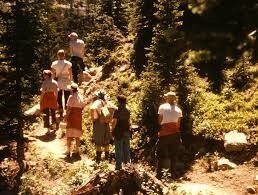Overcrowded & Undermaintained
Renee Cox
For several years, Colorado has consistently ranked as one of America’s “fittest” states. With more than 39,000 miles of trails winding throughout the colorful state, it is no wonder that the state has even held the number one position on more than one occasion. Not only do locals frequent the trails, but the striking beauty and vast wildlife of Colorado attract millions of visitors every year. Millions of visitors are, undoubtedly, incredible for local economies, but a looming concern has emerged: the impact of this magnitude of foot traffic on the trails and surrounding ecosystems.
Protecting and preserving natural resources is a top priority in Colorado, which is why it is important to direct attention to trail use, abuse, and maintenance efforts as well as possible alternative approaches to minimizing the ecological damage caused by human traffic. Funding is the most critical aspect when considering these concerns. Great Outdoors Colorado (GOCO), a grant program, dedicates a relatively consistent amount of funding to trail maintenance and construction every year, whereas federal sources have fluctuated significantly over the years. Despite the inconsistent amounts allocated to trail maintenance and construction, federal funding and grant programs comprise the primary sources of financial support.
Colorado agencies have been able to balance the trail funding budget effectively to accomplish maintenance and construction on only Colorado’s most trafficked trails, leaving countless trails untouched. Moreover, the steady increase in population in Colorado combined with the current mentality of “maintain what we have, first” regarding the overwhelming maintenance backlog results in over-trafficked and undermaintained trails. Colorado needs reliable sources of funding to meet the ever-increasing demand for navigable, accessible trails while attentively safeguarding the delicate ecosystems the trails guide hikers through.
In June 2011, U.S. Interior Secretary Ken Salazar declared Glenwood Springs’s Hanging Lake, a pristine lake resting upon a deposit of travertine, a National Natural Landmark. To witness Hanging Lake’s remarkable beauty, one must hike just over one mile in rocky terrain and wind through switchbacks before reaching the boardwalk that surrounds the lake. The travertine, or tufa, not only resulted in a gorgeous natural lake but its geology and hydrology also support a rare and fragile “hanging garden” ecosystem. Considered one of the best hikes in Colorado for both its natural wonder and distance, Hanging Lake attracted more 186,000 visitors in 2018 alone. That amount of human traffic resulted in both trail damage and threatened the fragile ecosystem of the site. As a result, in 2019, Glenwood Springs and the Forest Service established a permit reservation system, which limits the number of people on the trail at any given moment and caps the number of people who visit the trail on any given day. In addition to the protection efforts, the city of Glenwood Springs and the Forest Service boast that a percentage of the revenue from the permits will be used to maintain and sustain the site.
However, the actual percentage of the funds procured from the permits that has been, or will be, reinvested remains unclear. The City has simply stated that “[a]t a minimum, 5%” will be reinvested. While 5% of 186,000 permits would be no nominal amount, permit purchasing hikers may question where the remaining 95% of that revenue goes. Furthermore, permit hiking presents an equitable access dilemma for low-income individuals: either sacrifice funds for the permit or forfeit the opportunity to hike that trail. This represents yet another barrier for those individuals to gain access to recreational trails .
In late 2018, a bill regarding a “non-motorized recreational trail fee” was filed in the state of Wyoming. 2019 Bill Text WY D. 81. This bill proposes an annual ten-dollar fee for adults who use non-motorized recreational trails. In addition to proposing a fee amount and schedule, the bill establishes a fund into which these fees will be deposited, which is to be “continuously appropriated to the department of state parks and cultural resources for administration of the non-motorized recreational trail program . . . .” 2019 Bill Text WY D. 81. Furthermore, the bill recognizes the need for alternatives for individuals who may not be able to afford the annual fee and includes a provision for permits to be provided in exchange for volunteer hours dedicated to trail maintenance. 2019 Bill Text WY D. 81. This bill accounts for the funds, permits access to all trails for one annual fee, and contains an inclusivity subsection specifically for those who may not be able to pay the fee.
Safeguarding the unique ecosystems that Colorado trails snake through is imperative and requires a steady stream of funds along with a dedicated workforce. As of now, federal funding fluctuates and funding is largely derived from grants. Permit hiking could provide a short-term alleviation in the foot traffic on our trails and augment some of the funding difficulties, but such permits bring questions of equitable access as well as suspicions of the destination in those funds. Therefore, proposing a recreational trail fee, like the bill proposed in Wyoming, to be instituted in Colorado may provide the best avenue to solving the problems implicit to funding trail maintenance and construction.

